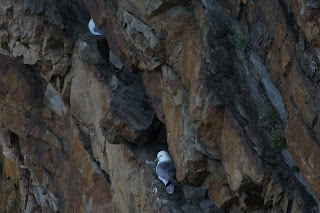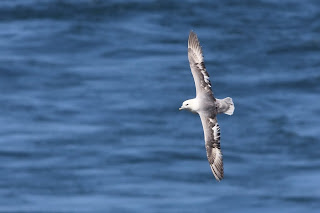It was 11 years since we both camped here last, and two things are indelibly imprinted on our memories; firstly a very confiding Grasshopper Warbler which sang away a few feet from the tent, and secondly the haunting calls of Manx Shearwaters flying overhead one night. Oddly enough, a Grasshopper Warbler started reeling away from exactly the same place as we got to grips with the tents.
Still, we pitched in the dry and relative calm of late afternoon and then settled down to watch the seabirds float by along the cliff and ocean. Dark clouds gathered on the horizon and wind and rain headed our way for the night.
The next morning, rather bleary eyed and sleepy after our buffetting, we got up to a much calmer day which became sunny and even quite warm by mid morning.
Russ and I walked in sunshine up to the Deer Park which is almost as far west in mainland Wales you can go without falling off. A great place for Chough amongst many other things, and they did not disappoint, busily looking for insects and grubs on the grassy top and in any vegetation they could find on the cliff faces.
For the record, regarding the above picture, I haven't ever seen a Chough do this before, in fact I'm not sure exactly what it is doing, maybe just stretching, whatever, its plummage is in fine fettle. While walking round from here, we both shouted "Peregrine" as one carved round the top of the cliffs and we got a few seconds good view before it disappeared. Then both of us noted that it was uncharacteristically brownish on the upper parts like a juvenile, but surely too early for this years offspring?
Spring flowers were in abundance, stunted Bluebells just coming out, Bladder Campion, Sea Thrift adding spots of pink and carpets of the diminuitive Squill adding its gentle blue.
It was great to see the small Fulmar nesting site is still there, fabulously inaccessible, their precarious ledges are quite viewable from one side.
Along with Gannets, these are some of my favourite seabirds in flight. Effortlessly steering the air with often unflappable attitude, these smallish birds remind me so much of the balsa gliders I stuck together as a child, I often get an urge to catch one and launch it into the wind.
I digress.
From the top of the cliffs at this end of the Deer Park, you look over a strong tidal race between the mainland and Midland Island, and behind that, Skomer. This churning channel is often frequented by all manner of fishing seabirds, and I hoped to get some good shots of Gannets, but only this solitary individual was present at the time.

Above the Fulmars, a soaking wet Raven arrived with something that looked suspiciously like a chick, or a bit of one, which it proceeded to go and feed to another one sat on the cliff. At the time I thought this was a pair, but as it turned out, this was a parent and fledgeling, and on a subsequent visit, proved to be one of three.
Ravens haven't had a good press through the ages, but I don't think there is much to match Ravens flying with total joie de vivre and amazing acrobatic skill on the breeze. I remember watching one hovering on an updraught and for no particular reason it just did a loop the loop back to the same spot. Similarly, I've seen them flying straight, close one wing and barrel roll just for the fun of it. I love them.

Amongst the scrub and blinding yellow Gorse were lots of smaller birds, largely Linnets and Meadow Pipits, but also Whitethroat, Skylark, Stonechat, Rock Pipit, Goldfinch and Wheatears, and a constant flow of Swallows overhead, possibly coming in off the sea.


Back at the campsite after a barbecue, we sat and watched the sun sink into the sea on a lovely calm evening to treat us to one of those sunsets you get here, perhaps not the most spectacular - sometimes the sun ignites the sea - but beautiful nonetheless. Amazing how much the light changes over the course of a few minutes at dawn and dusk.



In the gathering gloom, rafts of Manx Shearwaters started appearing as if by magic, waiting for the cover of darkness to return to their nest holes on Skomer to swap places with their partners for another 24 hour vigil underground.


The calm and dry night promised a good night's sleep, however, a certain Grasshopper Warbler, and our resident Sedge Warbler decided that the quiet of night was the best time to sing, that and a constant passage of Shearwaters, ensured another wakeful night, but in a nice way.










No comments:
Post a Comment